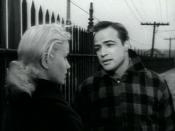Although the 1970s opened with Hollywood experiencing a financial low , the decade became a creative high point in the US film industry. Restrictions on language, adult content and sexuality, and violence had loosened up, and these characteristics became more widespread. And Hollywood was renewed and reborn with many new and experimental film-makers nicknamed "Movie Brats". The counter-culture had influenced Hollywood to take more risks and to experiment with alternative, young film makers, as old Hollywood professionals died out and a new generation of film makers came along many of the same audiences of the late 60s were the ones who supported stretching the boundaries of film even more in this decade. The Movie industry took big leaps in 1970 and had some first's an last's as in The IMAX wide-screen format premiered in the Fuji Pavilion at the Expo in Osaka, Japan. The popular landmark tear-jerker and commercially-successful film Love Story, adapted from Eric Segal's screenplay and thin novel, was the first modern romance film blockbuster.
By early 70's The blaxploitation film genre, with anti-Hollywood films aimed at a primarily African-American audience, was born with Melvin Van Peebles' groundbreaking Sweet Sweetback's Baadasssss Song! -- the first commercially-successful black-themed film. The landmark crime/action blaxploitation film Shaft, starring Richard Roundtree as a defiantly-proud black hero, was directed by Gordon Parks and would become a major cross-over hit. From then on through the end of the decade but mostly in the first half of the decade, over 200 films would be released by major and independent studios which featured major black characters and some black athletes such as Jim Brown and Rosie Grier to profit from the black movie-going audiences. Clint Eastwood and Charles Bronson would play similar hard-edged roles for whites. Blaxploitation cinema experienced a revival in the late 1990s, with...



Opinion
Good efforts made by writer
0 out of 0 people found this comment useful.